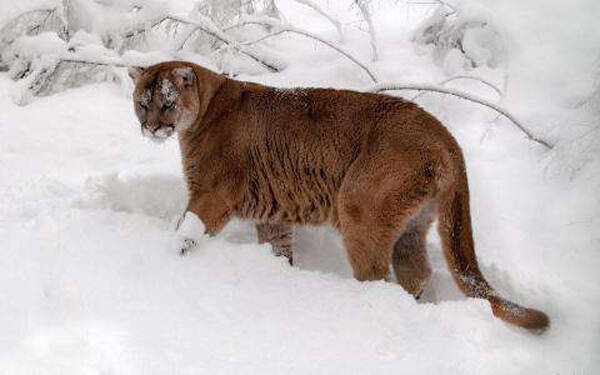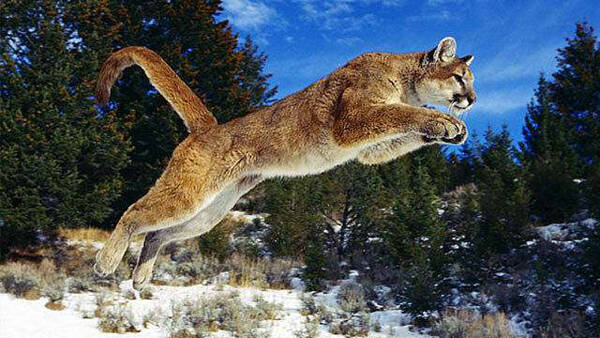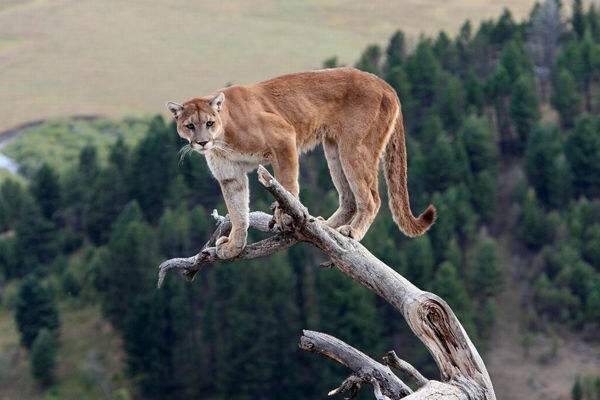Puma concolor
IUCN
LCBasic Information
Scientific classification
- name:Puma concolor
- Scientific Name:Puma concolor,Puma、Mountain Lion,Mountain lion, golden cat, pounce horse
- Outline:Carnivora
- Family:Felidae Catus
Vital signs
- length:86-154cm
- Weight:29-120kg
- lifetime:15-20years
Feature
It is about the same size as a leopard, but has no markings and a smaller skull.
Distribution and Habitat
The cougar is the most widely distributed mammal in the Americas, from the Yukon River Basin in Canada in North America to Argentina and southern Chile in South America. The distribution countries include Argentina, Belize, Bolivia, Brazil, Canada, Chile, Colombia, Costa Rica, Ecuador, El Salvador, French Guiana, Guatemala, Guyana, Honduras, Mexico, Nicaragua, Panama, Paraguay, Peru, Suriname, the United States and Venezuela.
The cougar lives in a variety of habitats such as forests, jungles, hills, grasslands, semi-deserts and mountains, including mountain coniferous forests, lowland tropical forests, shrubs, swamps and any area with sufficient cover and prey. It can adapt to a variety of climates and natural environments, and its survival altitude ranges from sea level to 5,800 meters above sea level. The cougar is an animal that likes to live in a hidden and peaceful environment, with dense vegetation, caves and rock crevices providing shelter.
Appearance
The cougar is the largest American cat, with males larger than females. The male head and body length is 1.02-1.54 meters, while the female head and body length is 860-1310 mm. The male tail is 680-960 mm long, while the female tail is 630-790 mm long. The male weight is 36-120 kg, while the female weight is 29-64 kg. The largest recorded cougar was photographed in Arizona, USA, weighing 125.5 kg. It has a round head, a wide snout, large eyes, short ears, and black spots behind the ears similar to those of a lion. Males and females do not have manes on their necks. The tail end also has tufts of hair like a lion, but not as obvious as that of a lion. The body hair is short and has no stripes. The back and the outer sides of the limbs are brown-gray, silver-gray and light purple, and the abdomen and the inner sides of the limbs are gray-white. The body is evenly proportioned, the limbs are medium-length, and the digitigrade walks. The vision, hearing, and sense of smell are all well dev
Details
Puma (scientific name: Puma concolor) is also known as Puma or Mountain Lion in foreign languages. It is an animal of the class Mammalia, family Felidae, and genus Cat. Based on the classical genetic analysis by Culver et al., 32 subspecies have been identified and described. In 2000, it was suggested to merge them into 6 subspecies.

Cougars often live in valley jungles, especially in trees. They have strong jumping ability and can reach more than 8 or 9 meters with a single jump. In America, they are the second most ferocious beast after the jaguar. However, they have a gentle character. Under normal circumstances, they do not actively attack people. Only when people attack them, they will injure and kill the attackers in self-defense. In America, some families catch young cougars and domesticate them. When they grow up, they can live in peace with cats and dogs and guard the door like dogs. They have earned the reputation of "friends of mankind".
Each female cougar's territory is about 50-60 square kilometers. They often rub against rocks as a way to mark their neighborhood. They also leave some scent on the road to tell other cougars that they have passed by here, so that male lions can find them by tracking. Cougars are active both day and night, often using trees and rocks as concealment, and then ambush prey. They usually approach their prey secretly and quietly. Cougars catch all prey they can see, 69% of which are various deer: white-tailed deer, black-tailed deer, red deer, moose, etc. They also catch other animals: squirrels, rabbits, otters, armadillos, peccaries, rodents, turkeys, fish, insects, porcupines, skunks and even grasshoppers, bats, frogs, sloths, tapirs, wild ducks, etc. They also prey on livestock and even attack humans.
Cougars are not good at getting along with each other. They only live in pairs for about two weeks a year during the estrus period, and then they go their separate ways and start their own independent lives again. Their senses are well developed, and their throats can make "purring" sounds like house cats. The cougar's call is very loud, but it cannot roar, and can only make a harsh and sharp high cry. It is good at swimming, climbing trees, and running. It can run 53-64 kilometers per hour. It has a strong jumping ability and can jump from a tree or cliff 12-13 meters high. It can also jump over a height of more than 3 meters to 6 meters or a distance of more than 5 meters to 13 meters. Therefore, it can catch prey within 20 meters with just two strong jumps.

Cougars are solitary, usually in groups of mothers and cubs, who guard their territories together and mark the boundaries with urine. Male territories are larger than female territories, and there are often overlapping territories of male and female cougars when there are multiple females in a male's territory. During the breeding season, female cougars have an estrus period of 8 days, and multiple males will initiate fights during this period. They will be inseparable for two weeks, mating up to 70 times a day.
The breeding season for mountain lions is irregular, and the female's gestation period is about 90 days. Usually in the late spring or early summer, the female gives birth to 1-6 cubs per litter, one every hour, in a cave or some secluded place. After the cubs are born, the female licks them clean and then raises her offspring alone. The newborn cubs have their eyes closed and are light yellow-brown with obvious light black spots and a black ring on their tail. It takes about two weeks for the cub's eyes to open. During this time, the cubs only sleep for a long time except for getting up to nurse. As they grow older, the spots on their bodies will gradually fade. For the first two years, the cubs are completely dependent on the female to get the food, warmth and security they need from their mother. Although they are born with some hunting skills, the female lion must not only teach the cubs to catch various prey, but also teach them to get used to a lonely and hidden life. At the age of one, the cubs' eyes become very bright, and they become very naughty little animals, with a body length of about 1.2 meters and a weight of nearly 20 kilograms. The growing cubs begin to constantly look out from the cave to the new and strange world outside the cave, and reluctantly take the first step outside the cave, but in order to prevent potential dangers from carnivores such as prairie wolves, the female lions always vigilantly protect them from any threats, including male cougars, because it is common for male cougars to attack and bite cubs to death, even sometimes their own offspring.
In order to survive, the cubs must gradually learn many things. The main responsibility for educating them is borne by the female, and the cubs are also divided into clear levels according to their strength, intelligence and agility, and the leader is always the strongest and most clever individual. The female uses her waving tail to teach the cubs to use their strengths and improve their ability to respond to things. In order to discipline and train the cubs, when she expresses anger, she usually slaps them gently, but she will never hurt the cubs. Although the cubs' activities in the first few months can be regarded as playing, this kind of play has a certain purpose, especially the game of hunting. In the future, they will rely on the skills learned from this kind of play to make a living. When the cubs grow to 3 months old, the female will take them out. She patiently gathers the cubs and takes them to the place where the prey is stored. However, most of the time, the female will only take one cub out when hunting, and leave the rest in the den, because it is very difficult for the female to approach the prey with all the cubs. The noise of the cubs is extremely unfavorable to the female who is looking for prey. More importantly, the female can only better train it to hunt if she takes one cub with her at a time. Cubs are sexually mature at 2-3 years old. Lifespan is 15-20 years.
Cougars are relatively easy to raise and breed in zoos. They give birth to 1-5 cubs per litter. Newborn puma cubs are as timid as their parents. They lie on the ground quietly like a little girl, looking very elegant and graceful, not at all like playful and naughty tiger cubs or leopard cubs. After the age of 3, they leave their mothers and start their own small family life.

In the early 1990s, cougar populations were estimated at 3500-5,000 in Canada and 10,000 in the western United States (Nowell and Jackson 1996). Populations in Central and South America are likely much higher, although it is unclear how abundant cougars are in the dense rainforests of the Amazon basin (Nowell and Jackson 1996). The Florida subpopulation is numbered at 100-180 individuals and is isolated and supplemented by cougars from Texas (Sunquist and Sunquist, 2002; Florida Fish and Wildlife Conservation Commission, 2014). In Brazil, it is considered endangered, but subspecies outside the Amazon are considered vulnerable (Machado et al., 2005). It is also considered endangered in Peru (Inrena 2006), Argentina (Diaz and Ojeda 2000) and Colombia (Rodriguez-Mahecha et al. 2006), and Data Deficient (unknown) in Chile (CONAMA 2005).
There are as many as 32 subspecies of cougars, based on their different distribution areas and differences in body size. One subspecies of cougar is already critically endangered, the "Florida subspecies", also called the Florida cougar or Florida panther. Because they have a dark-colored fur, which is very rare. There are only 75 in captivity and about 500 in the wild, and the population is very unstable. Their biggest threats come from water pollution, cars speeding on the road and lack of genetic diversity. In addition, Southeastern Cougars and Costa Rican Cougars are also endangered.
Brown bears often snatch cougars' food. Faced with huge brown bears, cougars usually choose to avoid them. In addition, cougars and black bears occasionally meet. Generally, cougars will take the initiative to avoid them, but in the encounter between bears and female cougars with cubs, female cougars will fight to the death to protect their cubs. The natural enemies of cougars are mainly American wolves. Cougars occasionally encounter jaguars, but compared with gray wolves, the chance of encountering jaguars is smaller. Wolves have always been the enemy of mountain lions. In conflicts between mountain lions and wolves, mountain lions often become the defeated enemies of wolf packs. Hungry wolf packs sometimes use mountain lions as food to fill their stomachs, and single wolves sometimes dare to fight mountain lions. The biggest natural enemy of mountain lions is undoubtedly humans. In the 20th century, at least tens of thousands of mountain lions died under the black muzzles of human guns every year. With the promulgation of animal protection laws, the hunting of mountain lions in the United States has slowed down.
Listed in Appendix I of the Washington Convention on the Protection of Species.
Listed in the Red List of Threatened Species of the World Conservation Union (IUCN) 2015 ver 3.1-Least Concern (LC).
Protect wild animals and stop eating game.
Maintaining ecological balance is everyone's responsibility!








